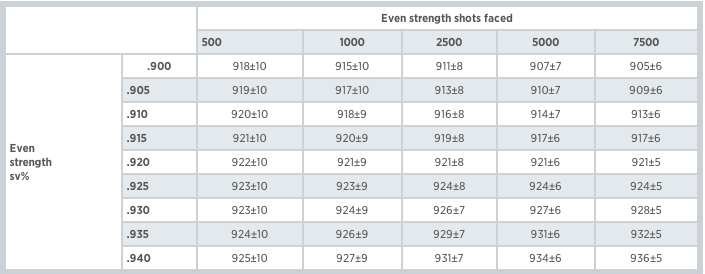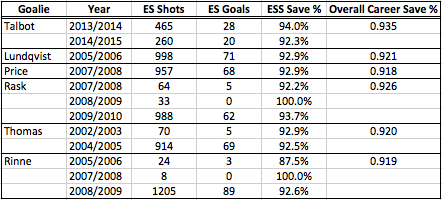Cam Talbot: Near and Long Term
With Henrik Lundqvist out, Cam Talbot is the number one man for the Rangers in the near future. While he's been a fine backup, have the Rangers been sitting on a future NHL starter this whole time?
Before all this Lundqvist injury hoopla the Rangers closed out a 3-2 victory over the Boston Bruins backstopped by Cam Talbot, who gave up 2 goals on 20 shots (on goal). Talbot was solid in net, but given the workload there were probably other games he himself would point to as being a "better" performance. As the game was winding down I went to look up his save percentage and noticed he was still above the 0.920 Overall Save Percentage mark, which is the ground-floor if you're to be considered a top-end NHL goalie in analytics circles. This made me do some research, which led to some simple number gathering, which led to me writing for the first time since last spring; all because Cam Talbot may be a legitimate number one NHL goaltender.
The true talent of an NHL goaltender, from a statistical standpoint, is a question of sample size. While scouting is key to unearth those with potential in order to prioritize those who get opportunities, in the end the more shots a goaltender can face against top players the more we can find out about his talent. This article is inspired from a piece from Eric Tulsky, which summarizes the work of Brian Macdonald on predicting goaltender talent. Why is sample size so important? In the words of Eric:
"A save percentage of .920 is a top-ten performance, while .910 would be nothing more than a good backup. But the difference between the two is just one save every 100 shots. That's an awfully narrow margin, and it takes an awfully large sample size to reliably identify differences that small. Much larger than you might expect -- several thousand shots, and even more if you want finer distinctions than top-ten versus good backup."
This applies to Cam Talbot because, as I alluded to, he has posted a very good save percentage and has thus been a very fine backup so far in his season and a half with the Rangers. In total, he has faced 725 Even Strength shots while allowing 48 Even Strength goals, good for a 0.934 Even Strength save percentage. With Lundqvist out for at least three weeks, Talbot should easily eclipse the 1000 Even Strength shot against mark, which will get us to another level in the below chart from Eric and Brian:

How does this chart work? Again, I'll leave it to Eric:
"For example, if your goalie has posted a .930 even-strength save percentage over 1,000 shots, you'd look at the .930 SV% row and the 1,000 shot column. There, you'd see "924±9", which means that we'd guess his true long-run talent is .924, and that there's a 95% chance he'll be within .009 of that (i.e. between .915 and .933). So you can use this table to estimate how confident your team should be in their young goalie, or which free agent they should pursue."
In the case of Talbot, this lands us in the 0.935 and 500 shot cell of the table, meaning his true long-run talent is anywhere between 0.914 and 0.934 at Even Strength save percentage with 95% confidence. While a 0.914 Even Strength save percentage would not be good, the range is still encouraging. If you haven't looked into Even Strength save percentages before, a goalie will typically have a ESS% over 0.925 if they're having a good year, as their overall save percentage is brought down by whatever numbers they post while on the Penalty Kill. For example, Lundqvist has a 0.936 ES save percentage this year while posting a 0.845 save percentage on the penalty kill - for only 15 to 20% of gameplay on average, the PK takes a toll on goaltenders.
To give some modern comparisons, I threw together this chart quickly. I'll preface the chart with this: I was lazy and didn't break out career Even Strength save percentages for the goalies, instead posting their overall number to the furthest right. While I wouldn't expect the trend of solid ES save percentage to change, I could be wrong.

Some pretty solid names saw some pretty similar numbers out of the gate, no? For the record, I just pulled those names off the top of my head - I would like to see any commenters bring up others as well. Now don't get me wrong, I have my doubts. The sample size is still low and Talbot's college and minor numbers can be debated - although they did progress up over time. And while I'm far from a goaltending scout, Talbot has a great frame while seeming very under control in his crease without much rebound concern.
It's crazy to think the Rangers have stumbled upon a potential successor to the Lundqvist throne seeing as he's not done quite yet, but at the same time the signs are optimistic to say the least. The next few weeks should be an interesting ride for the Rangers, and potentially a career-solidifying time for Cam Talbot as well.




